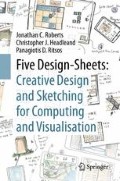Abstract
There are many situations when you need to plan and think through a range of different ideas, strategies, or courses of action. Often, your task is to find the right tools, or approach for a job and plan a solution to the problem at hand. In other situations is it useful to work through different permutations in your mind and decide which idea is the best to implement. Often though, it is initially difficult to know which design is best and how to proceed. This certainly applies to programmers, when they design and develop visual computer interactive interfaces, or visualisation tools that display big data. In particular, software engineers need often to consider various alternative designs and layouts, before they even think about beginning to program. In this book we present a method that will enable you to contemplate, decide upon and communicate different approaches and ideas. We call it the Five-Designs Sheet methodology, as it is based around sketching alternative designs in five structured sheets. Through presenting this method, we discuss techniques to help you contemplate your ideas, combine them to devise more complex plans and depict them in sketches. These sketches can them be implemented as interface solutions. This chapter covers the main concepts explored in the book and the different skills that we wish you to learn, including: (1) thinking through ideas, (2) preparing to sketch and (3) sketching different ideas and using the Five Design-Sheet methodology for design-thinking.
Access this chapter
Tax calculation will be finalised at checkout
Purchases are for personal use only
References
Crick F (1996) The impact of Linus Pauling on molecular biology. In: The Pauling symposium: special collections, The Valley Library, Oregon State University
Ericsson KA, Krampe RT, Tesch-Römer C (1993) The role of deliberate practice in the acquisition of expert performance. Psychol Rev 100(3):363
Gamma E, Helm R, Johnson R, Vlissides JM (1995) Design patterns: elements of reusable object-oriented software, 1st edn. Addison-Wesley Longman Publishing Co., Inc., Boston
Gladwell M (2008) Outliers: the story of success. Penguin, London
Heer J, Agrawala M (2006) Software design patterns for information visualization. IEEE Trans Vis Comput Graph 12(5):853–860. doi:10.1109/TVCG.2006.178
Kahneman D (2011) Thinking, fast and slow. Farrar, Straus and Giroux, New York
Rettig M (1994) Prototyping for tiny fingers. Commun ACM 37(4):21–27
Roberts JC, Headleand C, Ritsos PD (2016) Sketching designs using the five design-sheet methodology. IEEE Trans Vis Comput Graph. doi:10.1109/TVCG.2015.2467271
Roberts JC, Ritsos PD, Badam SK, Brodbeck D, Kennedy J, Elmqvist N (2014) Visualization beyond the desktop–the next big thing. IEEE Comput Graph Appl 34(6):26–34. doi:10.1109/MCG.2014.82
Rumbaugh J, Jacobson I, Booch G (2005) The unified modeling language reference manual, 2nd edn. Pearson Higher Education. Boston, United States.
da Vinci L (2005) Da Vinci notebooks. Profile Books, England, UK.
Author information
Authors and Affiliations
Rights and permissions
Copyright information
© 2017 Springer International Publishing AG
About this chapter
Cite this chapter
Roberts, J.C., Headleand, C.J., Ritsos, P.D. (2017). Introduction: Think, Prep, Sketch. In: Five Design-Sheets: Creative Design and Sketching for Computing and Visualisation. Springer, Cham. https://doi.org/10.1007/978-3-319-55627-7_1
Download citation
DOI: https://doi.org/10.1007/978-3-319-55627-7_1
Published:
Publisher Name: Springer, Cham
Print ISBN: 978-3-319-55626-0
Online ISBN: 978-3-319-55627-7
eBook Packages: Computer ScienceComputer Science (R0)

